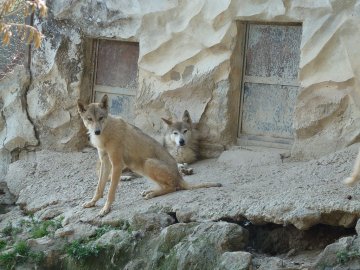Himalayan Wolf
Wolves are biggest in the dog family. The Indian subcontinent includes three distinct wolf lineages: Eurasian, Indian and Tibetan wolves. The Gray wolf is the most common type of wolf that most people are familiar with. The Himalayan wolf was believed to be a subspecies of Tibetan wolf, but recent scientific and genetic studies revealed that the Himalayan wolf belongs to a species of gray wolf.
Distribution
This particular species of wolf is found in some specific areas of India. They are found in Jammu and Kashmir, Nepal, China, Mongolia and the Himalayas. Earlier, as per the name, it was believed that Himalayan wolves lived only in the Himalayas. However, it was recently found that they survive in other regions as well.
Physical Description
Himalayan wolves are light tan in color and have grey shades on their body. Some wolves of this species have white or black shades around the face or along the chest.
Diet
Just like other species of wolves, the Himalayan wolf feeds on small and medium sized animals, including rabbits, raccoons and rodents. At times, they will take down the young of bigger sized prey. Wolves are skilled hunters. Hunting usually takes place at night and ends at dusk.
Behavior
Just like the red wolf, the Himalayan wolf is social by nature, and tends to remain in a group of wolves. As they are smaller in number, they have smaller groups, usually of six or eight members. Unlike red wolves that are very territorial and prevent other wolf packs from invading their territory, Himalayan wolves are not as aggressive when it comes to protecting their territory. This species of wolves rarely shows any physical level of confrontation with other species of wolves.
Reproduction
The Himalayan wolves are considered to be mature around the age of two. Hence, they stay in the group until the age of two till they are able to establish a territory. The females have an easier time being accepted to another pack. Males often have to find their own territory as well as mate that they can start a pack with. Generally, four or six pups are born to a female. The Himalayan wolf seems to be very protective of her offspring and take care of them in a den for the first few months. This protects their new born from being attacked by other wolf packs and predators. Some experts suggest that as Indian wolves and Himalayan wolves have more or less same geographic distribution, they may have engaged in cross breeding. However, there is no evidence to support that cross breeding has occurred.
Predator
Humans are the primary threat to Himalayan wolves. The indigenous inhabitants kill them indiscriminately as the wolves prey on their livestock. The Himalayan wolf was included on the Endangered Species List by the Indian Government in 1998. The nation has also started a Himalayan wolf breeding program to save this endangered species.

